Identification of critically carcinogenesis-related genes in basal cell carcinoma
- PMID: 30410353
- PMCID: PMC6199216
- DOI: 10.2147/OTT.S170504
Identification of critically carcinogenesis-related genes in basal cell carcinoma
Abstract
Background: Basal cell carcinoma (BCC) is a frequent malignant tumor of skin cancers with high morbidity. The objective of this study was to identify critical genes and pathways related to the carcinogenesis of BCC and gain more insights into the underlying molecular mechanisms of BCC.
Materials and methods: The gene expression profiles of GSE7553 and GSE103439 were downloaded from the Gene Expression Omnibus database with 19 tumors and 6 normal skin tissues. Differentially expressed genes (DEGs) were screened between BCC samples and normal tissues, followed by gene ontology and Kyoto Encyclopedia of Genes and Genomes pathway enrichment analysis. Subsequently, protein-protein interaction (PPI) network was constructed for these DEGs, and module analysis was performed.
Results: A total of 313 DEGs were obtained. Among them, 222 genes were upregulated and 91 genes were downregulated. Enrichment analysis indicated that the upregulated genes were significantly enriched in cell cycle and mitosis, while the downregulated genes were mainly associated with unsaturated fatty acid metabolic process and cell differentiation. In addition, TOP2A, CDK1, and CCNB1 were identified as the top three hub genes ranked by degrees in the PPI network. Meanwhile, three subnetworks were derived, which indicated that these DEGs were significantly enriched in pathways, including "cell cycle", "extracellular matrix-receptor interaction", "basal cell carcinoma", and "hedgehog signaling pathway".
Conclusions: The novel critical DEGs and pathways identified in this study may serve pivotal roles in the carcinogenesis of BCC and indicate more molecular targets for the treatment of BCC.
Keywords: basal cell carcinoma; bioinformatics analysis; differentially expressed genes; enrichment analysis.
Conflict of interest statement
Disclosure The authors report no conflicts of interest in this work.
Figures



References
-
- Eisemann N, Waldmann A, Geller AC, et al. Non-melanoma skin cancer incidence and impact of skin cancer screening on incidence. J Invest Dermatol. 2014;134(1):43–50. - PubMed
-
- Devine C, Srinivasan B, Sayan A, Ilankovan V. Epidemiology of basal cell carcinoma: a 10-year comparative study. Br J Oral Maxillofac Surg. 2018;56(2):101–106. - PubMed
-
- Narayanan DL, Saladi RN, Fox JL. Ultraviolet radiation and skin cancer. Int J Dermatol. 2010;49(9):978–986. - PubMed
-
- Lesiak A, Sobolewska-Sztychny D, Majak P, et al. Relation between sonic hedgehog pathway gene polymorphisms and basal cell carcinoma development in the Polish population. Arch Dermatol Res. 2016;308(1):39–47. - PubMed
LinkOut - more resources
Full Text Sources
Miscellaneous

